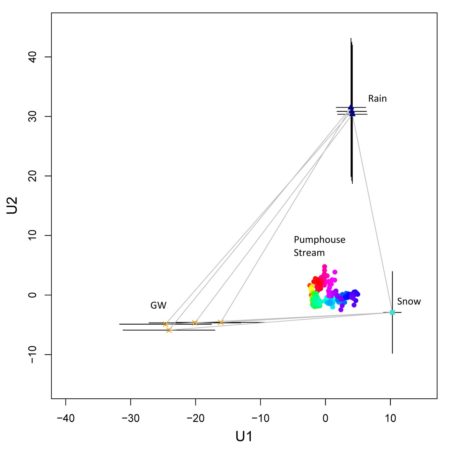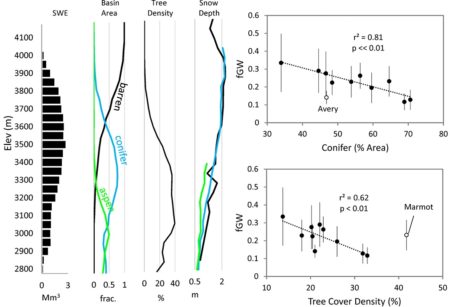
Fig. 1: Mixing diagram in U-space with Pumphouse stream discharge plotted in rainbow. Seasonal end-member means are connected with grey connecting lines while end-member variability (black error bars) determined using ±1sd of observed tracer concentrations.
Research identifies critical zone influences on hydrologic partitioning and tracer variability as reflected in seasonal stream concentration-discharge (C-Q) relationships. The method is applied across scale and within topographically complex, snow-dominated basins. First-order controls on seasonal streamflow generation are isolated and hydro-chemical conceptual model development is initiated.
The role of groundwater contribution to snow-dominated, low-order streams residing in basins of large relief is found significant; with recharge increasing in the upper sub-alpine where maximum snow accumulation is coincident with reduced conifer cover and lower canopy densities. Error in estimated stream concentrations is attributed to differences in water partitioning, source rock, seasonal shifts in flow path and sulfate reduction in floodplain sediments.

Fig. 2: Topographic and vegetation controls on snow water equivalent (SWE) and fraction of streamflow that is groundwater (fGW).
Summary
To isolate first-order controls on seasonal streamflow generation within highly heterogeneous, snow-dominated basins of the Colorado River, authors developed a multivariate statistical approach of end-member mixing analysis (EMMA) using a suite of daily chemical and isotopic observations. Mixing models are developed across 11 nested basins (0.4 km2 to 85 km2) spanning a gradient of climatological, physical and geological characteristics. Hydrograph separation using rain, snow and groundwater as end-members indicates that seasonal contributions of groundwater to streams is significant. Mean annual groundwater flux ranges from 12% to 33% while maximum groundwater contributions of 17% to 50% occur during baseflow. Groundwater recharge is found to increase in basins of high relief and within the upper sub-alpine where maximum snow accumulation is coincident with reduced conifer cover and lower canopy densities (Fig. 1). The mixing model developed for the furthest downstream site did not transfer to upstream basins. The resulting error in predicted stream concentrations points toward weathering reactions as a function of source rock and seasonal shifts in flow path. Additionally, the potential for microbial sulfate reduction in floodplain sediments along a low gradient, meandering portion of the river is sufficient to modify hillslope contributions and alter mixing ratios in the analysis. Soil flushing in response to snowmelt is not included as an end-member but is identified as an important mechanism for release of solutes from these mountainous watersheds.
Citation
R. W. H. Carroll, L. A. Bearup, W. Brown, W. Dong, M. Bill, and K. H. Williams, “Factors Controlling Seasonal Groundwater and Solute Flux from Snow-Dominated Basins.” Hydrological Processes, Special Issue: Water in the Critical Zone 32 (14), 2187-2202 (2018). [https://doi.org/10.1002/hyp.13151].
